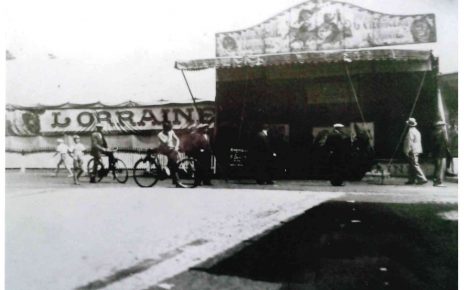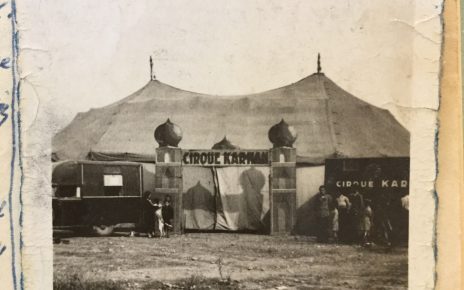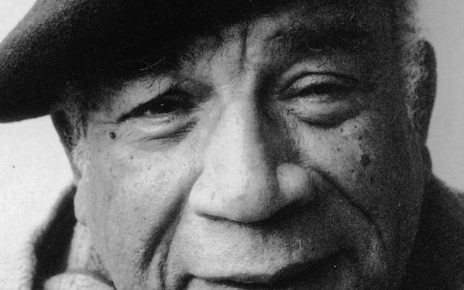“He had a spectacular scar that split his palm from index finger to his wrist,” recalls Bertrand Laurence of his strongman-acrobat grandfather, Houssein ben Ibrik. “It was from his early years in Morocco. To stop the attacking blade, he’d grabbed the sword of a pirate mounted on a camel. With his other hand, he swung a club and crushed the pirate’s head like an egg. I asked him about the incredible scars across his chest,” Laurence relates. “‘A lion wanted to intimidate me,’ ben Ibrik replied. ‘So, the lion stood up, stuck both paws on my torso, and plunged his claws into my pecs’.” It wasn’t a lion that put Houssein ben Ibrik in a wheelchair. It was also not the Nazis, though he’d been tortured by SS officers in a camp in occupied France, where he had been taken around 1942. (It was possibly Beaudésert in Bordeaux, which operated from 1941-1944.) It was the ravages of old age, following a lifetime of straining his body to its limits.
Born in 1890 in Marrakesh, Houssein ben Ibrik was the son of El Marrakh Benbrik and Henia Bent Hammou, a Tuareg woman of the desert. Following pathways that remain unclear, he began performing with an “Arab acrobat” troupe that eventually became attached to the Circus Busch in Germany. By 1934, he’d signed on to the legendary Circus Sarrasani as the strongman base of an Arabian pyramid, a signature act consisting of up to ten men and boys standing in formation on the shoulders of a single man. He also worked with big cats, not only lions but the more dangerous leopards and panthers. In addition to hearing many stories about his grandfather’s lion-taming prowess, Laurence relates, “I remember a suitcase full of glass negatives of his circus days. These images were fantastic! But upon seeing them, my mother flew into a rage and smashed them to pieces. But I remember some, including a standing portrait of my grandfather holding a black panther on a leash. He was wearing baggy trousers and a fez. Shirtless, he was posing with the lethal club in his other hand.”

Ben Ibrik’s daughter, Fatima, had been born and raised in the circus, leading one to speculate that screenwriter/director Hermann Kugelstadt might have seen her during the Nazi years and later wrote Dark Star (Der dunkle Stern, 1955) to grapple with its implications. Much like the German cult film, Toxi (1952), Dark Star told the story of a young cirus mischlingskind, a child of mixed race performing with the circus. In both films, the mothers are Aryan German and fathers are both foreign and Black, thus broadly matching Fatima ben Ibrik’s unusual background. To be sure, both films cast the girls as “Rhineland Bastards,” i.e. the daughters of Black American soldiers, but it’s the specific connection to the circus that here fuels the irresistible urge to speculation. In the person of Fatima ben Ibrik and her younger brother Ali, it was the case that actual mischlinge children were with the Sarassani circus, performing before thousands as the Third Reich ascended to power.
Houssein ben Ibrik and Gertrude, undated, probably around 1935, private archive of Paula Lee
In documentary footage of Ali taken by his son, Pascal Benbrik, Ali speaks briefly about their childhood with the Sarassani. Born in the shadow of the Nuremberg Laws (implemented in September 1935) condemning mixed-race offspring, Ali’s and Fatima’s very existence was not only proof of an extraordinary love between two unlikely people, but was also, inescapably, an act of political defiance. Incredibly, it’s possible that both children performed while Hitler was in attendance, for it remains a little-known historical fact that the Führer loved the circus. Numerous newspaper accounts attest that Hitler attended as many circus performances as he could, often in the company of Hermann Göring, who raised lion cubs as house pets. They both had special interest in the lion taming acts.
Their mother, Gertrude Appel, had run away from home. By chance, ended up seeking shelter with the circus, where ben Ibrik discovered her hiding in his tent. By all accounts, it was love at first sight. They married in 1936. “I think Gertrude left home because she was promised to a man she did not want,” Pascal Benbrik muses. “Whether he was a Nazi or not was not the criterion of flight. It must be understood that for most Germans, soldiers or civilians were not Nazis in the sense that we hear this today. They were in the army or perhaps sympathizers of National Socialism, Hitler’s Party, but did not actually join.” Politically, the mood in Germany shifted dramatically between 1933 and 1936 and accelerated between 1936 and 1939. Irrespective of her political views, Gertrude rejected Nazism from the moment she met her future husband, and she remained a loyal wife even after he was taken by the SS.
The rupture happened around 1943. Following his disappearance, Gertrude quit the circus and took both children to Zittau, where her sister and grandmother lived. There, she began an affair with an SS officer. As it turned out, it was in hopes of learning her husband’s fate. She learned that ben Ibrik was in France, where he was being forced to wrestle Nazi officers. He’d been chosen to star in this strange political theater because his (pre-ordained) losses affirmed racial hierarchies that put Aryan men on top, and Black men on the bottom. In a handwritten memoir, Ali describes visiting his father at this SS camp, seeing him through the eyes of a self-loathing child who despised the ragged man he couldn’t recognize as his father. Because she was older, Ali recalls, his sister did remember him. The visit was profoundly sad.
In 1944, the bombing of Dresden destroyed the architectural wonder that was the Sarrasani circus building. In the final days of the war, Gertrude perished in the bombing of Zittau, effectively orphaning the children, who were then around 7 and 9. Rescued from the rubble by the Red Cross, Fatima and Ali were eventually removed from Germany to France, based on the fact that their father was a citizen of its then-colony, Morocco. Black German orphans in postwar France, they did not speak any French. There was no happy reunion. Father and children did not search for each other. Haunted by the horrors of what they’d endured, they assumed it was impossible that the others could have lived through the bombing, beatings, and worse. It would be years before they found each other again. Ben Ibrik had quit performing, for there were no more Arab troupes in Europe. Instead, he found work as a mechanic. He died in 1980.
Author:
Sources:
Ali Benbrik, untitled, unpublished memoir
Susan Nance, How the Arabian Nights Inspired the American Dream, 1790-1935, University of North Carolina Press, 2009.
Billy Pape, “What’s Become of Arabian Tumblers?” Billboard (Nov. 29, 1947): 72.





